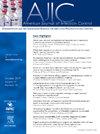Robotic versus manual disinfection of global priority pathogens at COVID-19-dedicated hospitals
IF 3.8
3区 医学
Q2 INFECTIOUS DISEASES
引用次数: 0
Abstract
Background
Twelve bacterial families identified as global priority pathogens (GPPs) pose the greatest threat to human health due to declining antibiotic efficacy. Robotics, a swift and contactless tool for disinfecting hospital surfaces, was sought to compare with manual disinfection.
Methods
The disinfection efficacy of a robot was compared with manual disinfection for multiple clinical surfaces and inanimate objects at two hospitals in Nepal using bleach (NaOCl). Surfaces were swabbed pre- and post-disinfection and total heterotrophic plate count evaluated, and bacterial pathogens identified using Gram’s staining and biochemical characteristics. Disinfection outcomes were reported as log reduction (log10 CFU/inch2) of heterotrophic count and presence or absence of GPPs: Staphylococcus aureus, Escherichia coli, Acinetobacter spp., and Klebsiella pneumoniae, among others.
Results
Both robotic and manual disinfection significantly reduced the microbial load (log 2.3 to log 5.8) on hospital surfaces. No pathogens were detected post-disinfection using the robot. Robotic disinfection was more effective, significantly reducing the bacterial load (log 5.8) compared to manual disinfection (log 3.95).
Conclusions
Our results showed better efficacy of robotic disinfection over manual disinfection of hospital surfaces, and thus contactless robotic disinfection is recommended for disinfecting surfaces in the hospital and clinical settings as it favors patient safety against GPPs.
2019冠状病毒病专门医院全球重点病原体的机器人与人工消毒。
背景:2017年,世界卫生组织将12个细菌家族确定为全球重点病原体,认识到它们对人类健康构成的最大威胁以及抗生素疗效的下降。机器人已经成为一种快速和非接触式的消毒医疗设施细菌表面污染的工具,然而,机器人与人工消毒的消毒效果的直接比较是有限的。本研究的目的是比较如何机器人消毒执行人工消毒对全球优先病原体在医疗保健设置。方法:研制一种喷雾消毒机器人,于2020年7月~ 2020年12月与人工消毒进行消毒效果比较。在尼泊尔的两家医院,使用机器人或人工消毒剂(NaOCl)对临床表面和无生命物体进行了消毒。在消毒前后收集两家医院的地板、床、门把手和医疗器械的拭子样本,检测异养平板总数,并根据革兰氏染色和生化特征鉴定细菌病原体。消毒结果报告为异养计数的对数减少(log10 CFU/inch2)和目标细菌的存在或不存在。从两个研究地点共收集了76份样本,包括主要病原体:金黄色葡萄球菌、大肠杆菌、不动杆菌和肺炎克雷伯菌等。结果:机器人和人工消毒均可显著降低医院微生物负荷(log 2.3 ~ log 5.8)。使用机器人消毒后未检出病原体。与人工消毒(log 3.95)相比,使用机器人消毒更有效,显著减少了更多的细菌负荷(log 5.8)。结论:我们的研究结果表明,与人工消毒医院表面相比,机器人消毒的效果更好,因此推荐非接触式机器人消毒用于医院和临床环境中表面细菌污染的消毒,因为它有利于患者安全,免受全球优先病原体的侵害。
本文章由计算机程序翻译,如有差异,请以英文原文为准。
求助全文
约1分钟内获得全文
求助全文
来源期刊
CiteScore
7.40
自引率
4.10%
发文量
479
审稿时长
24 days
期刊介绍:
AJIC covers key topics and issues in infection control and epidemiology. Infection control professionals, including physicians, nurses, and epidemiologists, rely on AJIC for peer-reviewed articles covering clinical topics as well as original research. As the official publication of the Association for Professionals in Infection Control and Epidemiology (APIC)

 求助内容:
求助内容: 应助结果提醒方式:
应助结果提醒方式:


